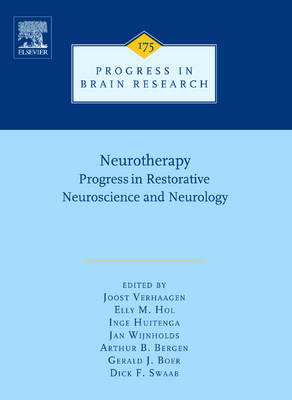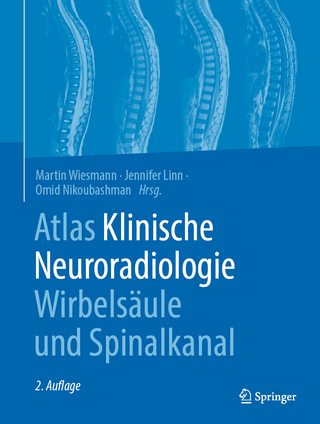
Neurotherapy
Elsevier Science Publishing Co Inc (Verlag)
978-0-12-374511-8 (ISBN)
This book focuses on the exciting recent progress in restorative neurology and neuroscience. The book includes chapters on major neurodegenerative disorders of the brain and the visual system, including Parkinson's disease, Alzheimer's disease, amyotrophic lateral sclerosis, Huntington's disease, macular degeneration, retinitis pigmentosa, glaucoma, spinal cord trauma, and multiple sclerosis. The primary goal of the book is to give an overview of new developments in translational research and in potential therapeutic strategies, including stem cell therapy, immunotherapy, gene therapy, pharmacotherapy, neuroprostheses and deep brain stimulation.
Elly Hol is professor of “Glia biology of brain diseases at the Utrecht University and professor of "Biology of glia and neural stem cells at the University of Amsterdam. Her research is focused on the role of glial cells in brain diseases, including Alzheimer’s disease, stroke, schizophrenia and glioma. The overall aim is to elucidate the molecular and functional changes in glia that contribute to the pathogenesis of neurological and psychiatric diseases. Her work is translational and includes studies on glial cells in human post-mortem brain tissue, in human cell models, and in mouse models for brain diseases. She is a member of Academia Europaea, member of the editorial board of Glia, chair of the scientific advisory board of Alzheimer Nederland, chair of GliaNed, director of the Neuroscience Master and PhD program of the Utrecht University Graduate School of Life Sciences, and director of education for the Division Brain at the UMCU. Dick Swaab (1944) earned his medical and doctoral degrees at the University of Amsterdam, where he became involved in brain research during his third year of medical school. He was Director of the Netherlands Institute for Brain Research from 1978 to 2005. Since 1979 he is Professor of Neurobiology at the Medical Faculty, University of Amsterdam. In 1985, Dr. Swaab founded the Netherlands Brain Bank (NBB) to serve as a source of clinically and neuropathologically well-documented research tissue. Since its founding, the Brain Bank has provided samples from more than 4,000 autopsies to 500 research groups in 25 countries. He was director of the NBB until 2005. He is Leader Research team Neuropsychiatric Disorders, Neth. Inst for Neuroscience, an institute of the Royal Netherlands Academy of Arts and Sciences (KNAW). Swaab is also appointed for 2011-2017 Chao Kuang Piu Chair of Zhejiang University, Hangzhou, P.R. China. His major research interests focus on, sexual differentiation of the human brain in relation to gender identity and sexual orientation, aging of the brain, Alzheimer’s disease, the neurobiological basis of depression, suicide and eating disorders. He has published over 540 papers in SCI journals, authored more than 200 chapters in books, and edited more than 60 books. Swaab mentored 84 PhD students from which 16 are now full professor. He is “Companion in the Order of the Dutch Lion, bestowed by her Royal Majesty Queen Beatrix of the Netherlands. In 2008 Swaab obtained the Academy medal for his role in national and international neuroscience. Dick Swaab is author of the 2 volume monograph The Human Hypothalamus that appeared in the Handbook of Clinical Neurology series, Elsevier, Amsterdam (1000 pp) and the Dutch best seller We are our Brains (450.000 copies sold), that is translated in 14 languages. A children's version of the book (You are your brains) has also appeared in Dutch in 2013 and Russian (2014). Swaab's H-factor is 76.
Section - Stem Cells
Jeffrey Macklis - Boston, USA Stem cell recruitement in the adult cortex following spinal cord injury
Scott Whittemore - Louisville, USA Application of embryonic stem cells in spinal cord repair
Peter Burbach - Utrecht, The Netherlands Molecular programming of stem cells into mesodiencephalic dopaminergic neurons
Ole Isacson - Belmont, USA Stem cell transplantation in Parkinson disease
Robin Ali - London, UK Retinal repair by transplantation of photoreceptors
Thomas Reh - Seattle, USA Efficient generation of retinal progenitor cells from human embryonic stem cells
Maurice Curtis - Gotenborg, Sweden Discovery of a rostral migratory stream in the adult human brain
Magdalena Götz - Munich, Germany Glial cells as stem cells ? a new view on reactive gliosis
Urban Lendahl - Stockholm, Sweden Molecular regulation of stem cell differentiation
Anders Björklund - Lund, Sweden Cell and gene therapy repair stategies for Parkinson disease
Section Immunotherapy and vaccination therapy
Roger Nitsch - Zurich, Switzerland Immunotherapy of Alzheimer's disease
Cynthia Lemere, Boston, USA Developing novel immunogens for effective and safe Alzheimer disease vaccine
Frank Baas - Amsterdam, the Netherlands Complement therapy promotes peripheral nerve regeneration
Philip Popovich - Columbus, USA T-cell and macrophage involvement in neuroregeneration
Hans van Noort - Rijswijk, The Netherlands Toll-like receptors in the CNS: implications for neurodegeneration and repair
Section Gene Therapy
Alan Harvey - Perth, Australia Gene therapy and transplantation in CNS repair: the visual system
Raymond Bartus - San Diego, USA Gene therapy for Alzheimer's and Parkinson's disease
Krys Bankiewicz - San Francisco, USA AAV-AADC gene therapy for Parkinson disease
Martijn Tannemaat - Amsterdam, the Netherlands Promoting regeneration of injured peripheral nerves and avulsed spinal ventral rootsby gene therapy
Mimoun Azzouz - Sheffield, UKGene therapy for ALS based on retrograde delivery of transgenes with equine LV vectors
Bill Hauswirth - Gainesville, USA Cone photoreceptor targeted gene therapy
Pharmacotherapy
Iqbal Sayeed - Atlanta, USA Progesterone as a neuroprotective factor in traumatic and ischemic brain injury
Stefan Gold - Los Angeles, USA Oestrogen and testosterone replacement therapies in neurologic and psychiatric disorders
Reinier Schlingemann - Amsterdam, the Netherlands Treatment of retinal diseases with VEGF antagonists
Hans-Werner Müller - Düsseldorf, Germany Pharmacological modification of the extracellular matrix to promote regeneration of the injured brain and spinal cord
Yvo Roos - Amsterdamdam, the Netherlands First aid for the brain: successful reanimation strategies after stroke
Fabrizio Benedetti - Turin, Italy Placebo responses in neurological disorders
Neuroprostheses
Thomas Stieglitz - Freiburg, Germany Brain-computer interfaces
Gerald Chader - Los Angeles, USA Visual performance with retinal prostheses
Vittorio Colletti - Verona, Italy Alternative neurosurgical approaches for auditory brain implants
Richard Normann - Salt Lake City, USA Neuronal ensemble control of prosthetic devices by a human with tetraplegia
Edward Tehovnik ? Cambridge, MA, USA Microstimulation of the visual cortex to restore vision
Miguel Nicolelis - Durham, USA Control of artificial limb in monkeys: feedback by neural stimulation
Deep Brain Stimulation, FES and TMS
Alim-Louis Benabid - Grenoble, France Deep brain stimulation for neurological disorders: an historical perspective
Reggie Edgerton - Los Angeles, USA Potential for restoring neuromotor function via activity-dependent mechanisms
Vivian Mushahwar - Edmonton, Canada Intraspinal microstimulation and oscillating field stimulation
Damiaan Denys - Amsterdam, the Netherlands Deep brain stimulation: obsessive compulsive disorder
Diego Centonze - Rome, Italy Repetitive transcranial magnetic stimulation of the motor cortex ameliorates spasticity in multiple sclerosis
Mechanisms of spontaneous plasticity and regeneration
Christian Lohmann ? Amsterdam, The Netherlands Simultaneous imaging of morphological plasticity and calcium dynamics in dendrites
Catherine Lubetzki - Paris, France Axonal signals in central nervous system demyelination: the semaphorins
Massimo Filippi - Milan, Italy Magnetic resonance techniques to quantify tissue damage, tissue repair and functional cortical reorganization in multiple sclerosis
Henning Voss - New York, USA Diffusion tensor imaging as a tool to study neuronal plasticity and regeneration
James Fawcett - Cambridge, UK Molecular control of brain plasticity and repair
| Reihe/Serie | Progress in Brain Research |
|---|---|
| Sprache | englisch |
| Maße | 192 x 262 mm |
| Gewicht | 1500 g |
| Themenwelt | Medizinische Fachgebiete ► Chirurgie ► Neurochirurgie |
| Medizin / Pharmazie ► Medizinische Fachgebiete ► Neurologie | |
| ISBN-10 | 0-12-374511-X / 012374511X |
| ISBN-13 | 978-0-12-374511-8 / 9780123745118 |
| Zustand | Neuware |
| Informationen gemäß Produktsicherheitsverordnung (GPSR) | |
| Haben Sie eine Frage zum Produkt? |
aus dem Bereich


